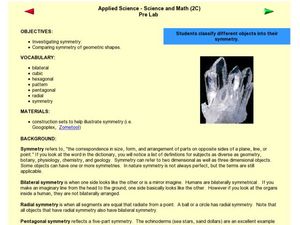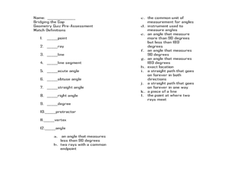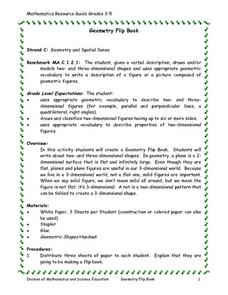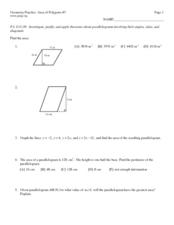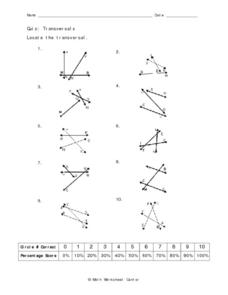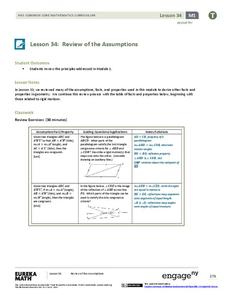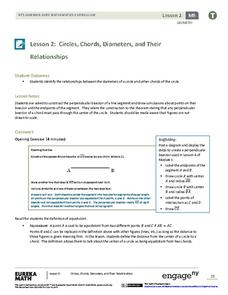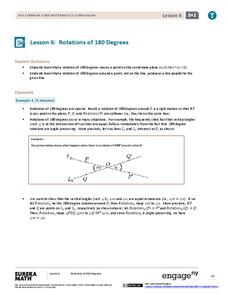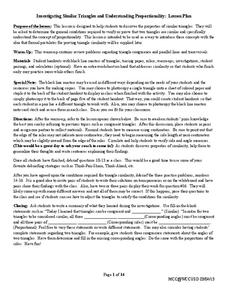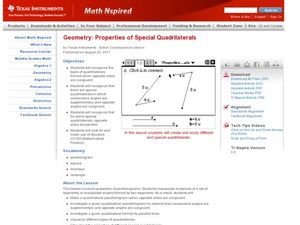Curated OER
Symmetry
Sixth graders explore symmetry and discuss the difference between a rotation and reflection. Using hands-on activities, such as folding paper shapes, they discover how to find the lines of symmetry and symmetrical characteristics. As a...
Curated OER
Number in Geometry
Students use a number line to assist with their additions. They use a calculator to check for factors. Students are taught factors and multiples. They use array model of multiplication to define meaning. Students develop a wide range of...
Illustrative Mathematics
Slopes and Circles
An upper-level treatment of what is often presented as a basic concept (the right angle of an inscribed circle on the diameter), this activity really elevates the mathematical thought of the learner! Expected to develop formulas...
Curated OER
2-D Geometry
Third graders describe and compare attributes of two-dimensional shapes. They explain geometric terms, angles and shapes. Students demonstrate each vocabulary word with their body and they mirror the body positions associated with each...
Curated OER
Lines and Angles
Students explore Geometry with Twizzlers Candy, pipe cleaners, paper, pencils, and protractors. They manipulate these items to create different angles introduced by the teacher.
Curated OER
Geometry in Tessellations
Students examine tessellations and their geometric properties. Students explore the concept of tessellations and lines, planes, angles, and polygons. Students experiment with the area and perimeter of polygons. Students analyze...
Curated OER
Lines In Geometry
Students define important vocabulary words using a dictionary. In this geometry instructional activity, students identify and use properties of triangles to solve problems. They identify the median. altitude and angles as well as...
Curated OER
Geometry Definitions
In this geometry learning exercise, learners match the geometry term with its definition. Students match 12 geometry terms with their definitions.
Curated OER
Geometry and Quilting
Fourth graders combine geometry and language arts skills while examining quilt-making. After identifying the geometric shapes contained in quilts, they write stories to encompass the quilt border. Students conclude by creating and...
Curated OER
Geometry Flip Book
Students investigate the concepts of geometry that can be grouped into a flip book that can be used for teaching and review purposes. They define the differences between two and three dimensional figures. Also polygons are reviewed and...
Curated OER
My Test Book: Geometry skills
In this online interactive math skills worksheet, students solve 10 multiple choice math problems regarding geometry skills. Students may view the correct answers.
Curated OER
Geometry Practice: Area of Polygons #3
Students find the area of two parallelograms. One answer is multiple choice, the other is a short answer. Students graph four lines, and find the area of the parallelogram formed by these lines. Students explain the angle that will give...
Curated OER
Geometry: Shapes-Squares, Rectangles and Triangles
In this geometry worksheet, students distinguish which of eight shapes are squares, rectangles and/or triangles. Students write the name of each shape on the lines provided.
Curated OER
Transversals
In this transversal worksheet, students identify the transversal in given diagrams. This one-page worksheet contains ten identification problems.
Curated OER
Measuring Angles
Third graders describe an amount of turn from a particular position to another using the 'circular' benchmarks of 0, ++, ++, ++, and full turn. Estimation language such as 'just about', 'between', 'not quite', 'just over', and similar...
Curated OER
Angles, Parallel Lines, and Polygons
Students examine how to investigate polygons using an instrument of their own construction. They should be able to prove the general formula for the number of degrees in any polygon (including a triangle). Finally they investigate an...
EngageNY
Construct a Perpendicular Bisector
How hard can it be to split something in half? Learners investigate how previously learned concepts from angle bisectors can be used to develop ways to construct perpendicular bisectors. The resource also covers constructing a...
EngageNY
Characterize Points on a Perpendicular Bisector
Learn transformations through constructions! Pupils use perpendicular bisectors to understand the movement of a reflection and rotation. They discover that the perpendicular bisector(s) determine the line of reflection and the...
EngageNY
Review of the Assumptions (part 2)
Is the amount of information getting overwhelming for your geometry classes? Use this strategy as a way to organize information. The resource provides a handout of information studied in relation to triangle congruence. It includes a...
EngageNY
Circles, Chords, Diameters, and Their Relationships
A diameter is the longest chord possible, but that's not the only relationship between chords and diameters! Young geometry pupils construct perpendicular bisectors of chords to develop a conjecture about the relationships between chords...
EngageNY
Rotations of 180 Degrees
What happens when rotating an image 180 degrees? The sixth lesson in the series of 18 takes a look at this question. Learners discover the pattern associated with 180-degree rotations. They then use transparency paper to perform the...
West Contra Costa Unified School District
Investigating Similar Triangles
Let your use of the resource be in proportion to its usefulness. Pupils investigate similar triangles by measuring side lengths and considering given angle measures. The results of the investigation help develop generalizations about...
Curated OER
Secants, Tangents and Arcs
Students identify chords and angles. In this geometry lesson, students calculate the length of the chords inside and outside of-the circle. They differentiate between tangent and secant lines.
Curated OER
Properties of Special Quadrilaterals
Teach your mathematicians how to identify the properties of quadrilaterals. In this geometry lesson, high schoolers solve for missing angles and sides of a special quadrilateral. They use the TI to move the sides around and create...


